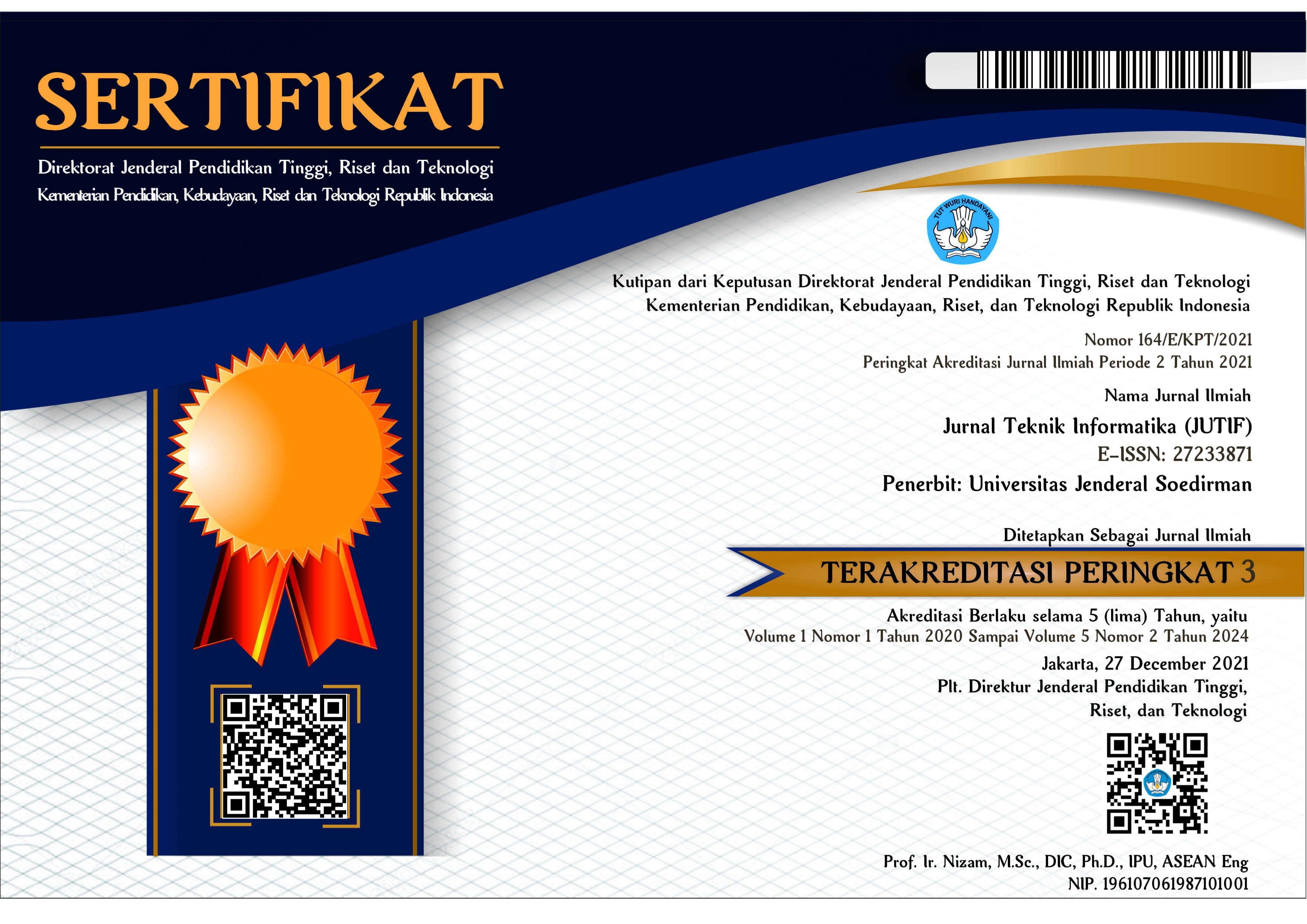WEBINAR STUDENT PRESENCE SYSTEM BASED ON REGIONAL CONVOLUTIONAL NEURAL NETWORK USING FACE RECOGNITION
DOI:
https://doi.org/10.20884/1.jutif.2021.2.2.82Keywords:
deep learning, face recognition, neural network, Regional Convolutional Neural NetworkAbstract
World health organization announce Covid-19 as a pandemic so On March 15th 2020, the social distancing has been established with working, learning, and praying from home. Webinar is one of the solutions so those activities still can be done face to face and conference-based. With webinar, users can interact each other in an online meeting from home. Student presence is part of a webinar. The purpose of this research is to design an accurate student presence with a face recognition system using R-CNN method. The object of this research is a human face with sufficient light, medium, and the face must be facing the camera. This research proposed for a webinar student presence system is using face recognition with Regional Convolutional Neural Network (R-CNN). With object detection and several scenarios used in this method, the webinar student presence system using R-CNN will be more accurate than the methods that have ever been used before. This research has done four scenarios to obtain the best parameters like 45 of total layers, test data of the whole dataset percentage as 10%, RMSProp as model op- timizer, and 0.0001 learning rate. With those parameters, it have resulted the best system performance including 99.6% accuration, 1 × 10-4 loss, 100% precision, 99% recall, and 99.5% F1 Score.
Downloads
References
E. Yulianto, P. D. Cahyani, and S. Silvianita, “Perbandingan Kehadiran Sosial dalam Pembelajaran Daring Menggunakan Whatsapp groupdan Webinar Zoom Berdasarkan Sudut Pandang Pembelajar Pada Masa Pandemic COVID-19,” J. Ris. Teknol. Dan Inov. Pendidik., vol. 3, no. 2, pp. 331–341, 2020.
H. Hasan, “Optimalisasi Google Form Dalam Pembelajaran Bahasa Arab di Era Pandemi Covid-19,” Pros. Konf. Nas. Bhs. Arab, vol. 6, no. 6, pp. 181–192, 2020.
M. dan B. S. Zufar, “Convolutional Neural Networks untuk Pengenalan Wajah Secara Real-Time,” SAINS DAN SENI ITS, vol. 5, no. 2, pp. 2337–3520, 2016.
P. P. Arhandi, U. D. Rosiani, A. Prasetyawati, and P. Choirina, “Sistem Pengenalan Wajah Untuk Keamanan Folder Menggunakan Metode Triangle Face,” J. Inform. Polinema, vol. 4, no. 4, pp. 268-273, 2018.
Y. dan Ida Nurhaida, “Rancang Bangun Aplikasi Pengenalan Wajah menggunakan Metode Viola-Jones dan Algoritma PCA,” Telekomun. dan Komput., vol. 8, no. 3, pp. 196-204, 2018.
N. D. Miranda, L. Novamizanti, and S. Rizal, “Convolutional Neural Network Pada Klasifikasi Sidik Jari Menggunakan Resnet-50,” J. Tek. Inform., vol. 1, no. 2, pp. 61–68, 2020.
C. Lesmana, R. Lim, and L. W. Santoso, “Implementasi Face Recognition menggunakan Raspberry pi untuk akses Ruangan Pribadi,” J. Infra, vol. 7, no. 1, pp. 63–66, 2019.
E. Indra, M. D. Batubara, M. Yasir, S. Chau, and others, “Desain dan Implementasi Sistem Absensi Mahasiswa Berdasarkan Fitur Pengenalan Wajah dengan Menggunakan Metode Haar-Like Feature: Sistem Informasi,” J. Teknol. Dan Ilmu Komput. Prima, vol. 2, no. 2, pp. 11–18, 2019.
I. Putra, “Klasifikasi citra menggunakan convolutional neural network (CNN) pada caltech 101,” Institut Teknologi Sepuluh Nopember, 2016.
S. Kido, Y. Hirano, and N. Hashimoto, “Detection and classification of lung abnormalities by use of convolutional neural network (CNN) and regions with CNN features (R-CNN),” in 2018 International Workshop on Advanced Image Technology (IWAIT), 2018, pp. 1–4, doi: 10.1109/IWAIT.2018.8369798.
J. R. Kala, D. M. Kre, A. N. Gnassou, J. R. K. Kala, Y. M. A. Akpablin, and T. Coulibaly, “Assets management on electrical grid using Faster-RCNN,” Ann. Oper. Res., pp. 1–14, 2020.
A. K. Nandi and H. Ahmed, “Deep Learning,” in Condition Monitoring with Vibration Signals: Compressive Sampling and Learning Algorithms for Rotating Machines, Wiley-IEEE Press, pp. 279–305, 2019.
M. A. Pangestu and H. Bunyamin, “Analisis Performa dan Pengembangan Sistem Deteksi Ras Anjing pada Gambar dengan Menggunakan Pre-Trained CNN Model,” J. Tek. Inform. dan Sist. Inf., vol. 4, no. 2, pp. 341–348, 2018.
S. Ilahiyah and A. Nilogiri, “Implementasi Deep Learning Pada Identifikasi Jenis Tumbuhan Berdasarkan Citra Daun Menggunakan Convolutional Neural Network,” JUSTINDO (Jurnal Sist. dan Teknol. Inf. Indones., vol. 3, no. 2, pp. 49–56, 2018.
J. Julpan, E. B. Nababan, and M. Zarlis, “Analisis Fungsi Aktivasi Sigmoid Biner dan Sigmoid Bipolar dalam Algoritma Backpropagation pada Prediksi Kemampuan Siswa,” J. Teknovasi J. Tek. dan Inov., vol. 2, no. 1, pp. 103–116, 2018.
A. Nasuha, T. A. Sardjono, and M. H. Purnomo, “Pengenalan Viseme Dinamis Bahasa Indonesia Menggunakan Convolutional Neural Network,” J. Nas. Tek. Elektro dan Teknol. Inf., vol. 7, no. 3, pp. 258–265, 2018.
R. D. Nurfita and S. T. Gunawan Ariyanto, “Implementasi Deep Learning Berbasis Tensorflow Untuk Pengenalan Sidik Jari,” Universitas Muhammadiyah Surakarta, 2018.
O. N. Putri and others, “Implementasi Metode CNN dalam Klasifikasi Gambar Jamur pada Analisis Image Processing (Studi Kasus: Gambar Jamur dengan Genus Agaricus dan Amanita),” 2020.
Y. Gultom, A. M. Arymurthy, and R. J. Masikome, “Batik classification using deep convolutional network transfer learning,” J. Ilmu Komput. dan Inf., vol. 11, no. 2, pp. 59–66, 2018.
Y. I. Kurniawan, and T. I. Barokah, "Klasifikasi Penentuan Pengajuan Kartu Kredit Menggunakan K-Nearest Neighbor," Jurnal Ilmiah Matrik, vol. 22, no. 1, pp 73-82, 2020.
A. A. Rahman, and Y. I. Kurniawan, "Aplikasi Klasifikasi Penerima Kartu Indonesia Sehat Menggunakan Algoritma Naïve Bayes Classifier," Jurnal Teknologi dan Manajemen Informatika, vol. 4, no. 1, 2018.











